The Polish internet has one answer to this question. The image of Jews greeting the entering Red Army with flowers was permanently engraved in the collective memory of the Kresowiaks and penetrated into public opinion. The joyful reception was to be an introduction to collaboration on a large scale. Was it really so? We check!
Greetings of the Red Army with flowers and red flags, and often triumphal gates, were organized in many cities and towns in eastern Poland. Even an orchestra played in Brześć nad Bugiem. In Lviv:
The Jews were very happy [when the Soviet army entered], so many of them approached the walking tanks and kissed the iron, shouting "nechej alive red army, we demanded 22 goda".
From Białystok, for example, it was reported: Jews greeted with Soviet banners and flowers, clung to machines . Similar scenes were to take place in the entire Kresy, from Lviv to Vilnius, from small towns in Podlasie, such as Łapy or Wasilków, to the largest cities.
Such events are confirmed by the memories of the Jews themselves. One of them wrote about Dereczyn (Słonim district): the entire Jewish community, as well as many non-Jews, went out to greet the Soviet saviors (...). Our joy was limitless (…). Almost the days of the Messiah .
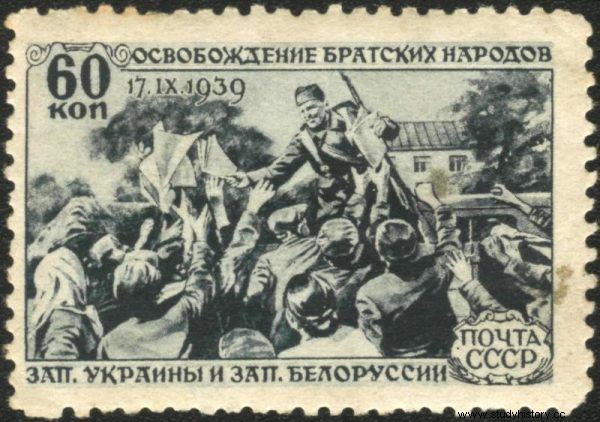
"Liberation of the fraternal nations of Western Ukraine and Western Belarus" - this is how, according to Soviet propaganda, aggression against Poland was to be remembered (source:public domain).
Who said hello?
It is impossible to establish what percentage of those who welcomed the Red Army were Jews. Apart from them, numerous Ukrainians and Belarusians undoubtedly participated in such ceremonies, and there were also Poles, generally described by witnesses of these events as "scum" and communists. The proportions certainly varied from place to place. In relation to some, it will be crowds, in relation to others - only a handful and even incidental nature of greetings.
It is all the more difficult to establish what percentage of the Jewish population took part in these greetings or simply rejoiced at the advent of Soviet power. Some accounts speak of "all" Jews and representatives of various social groups. The analysis of the memories shows, however, that the youth, the poor, representatives of the social margin and communists, as well as refugees from the lands occupied by the Germans, definitely dominated among the Jews.
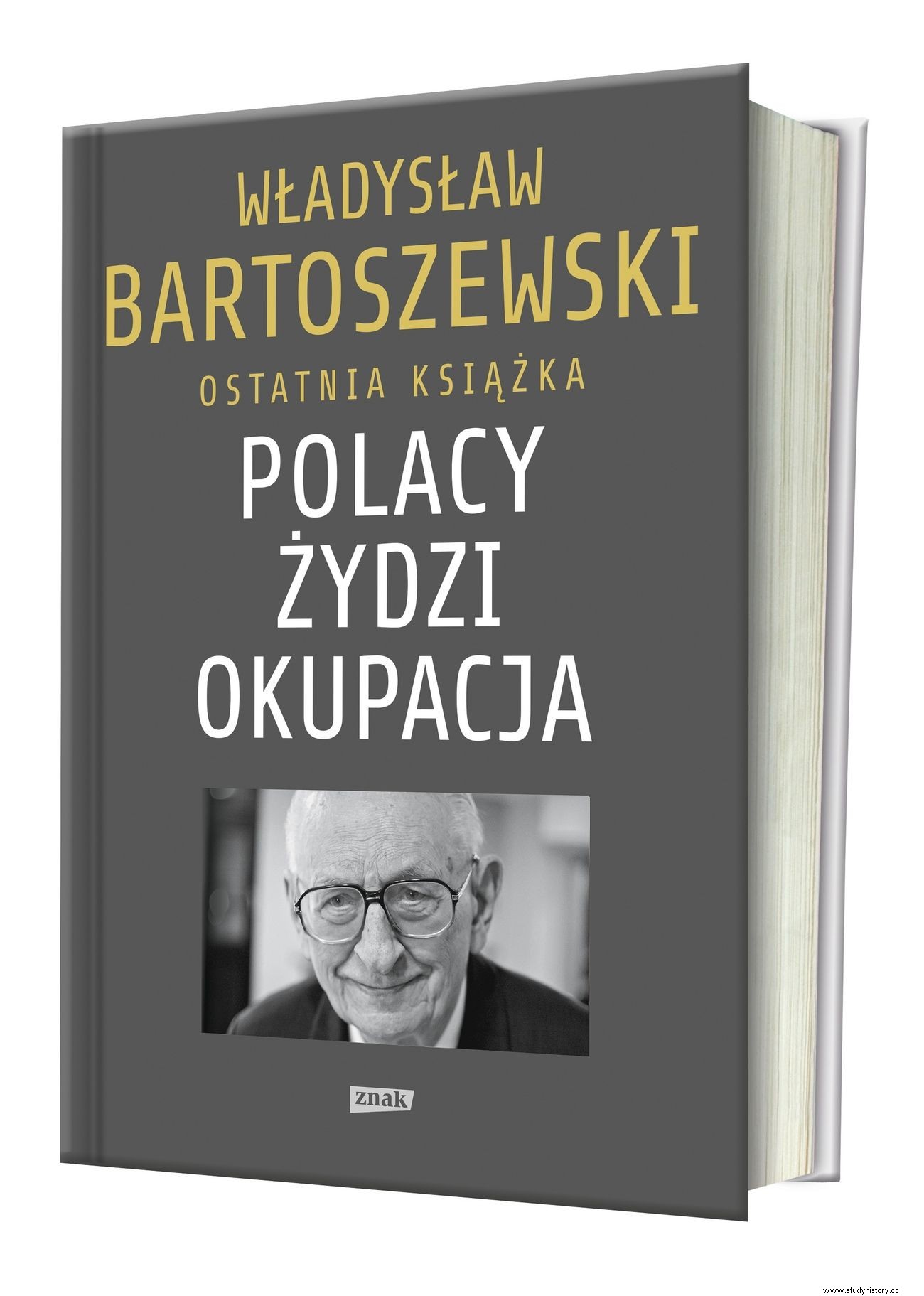
The article was inspired by the book by Władysław Bartoszewski, 'Poles - Jews - Occupation. Facts. Attitudes. Reflections "(Znak Horyzont 2016).
It should be remembered that, contrary to stereotypes, it was poor Jews who constituted the vast majority of representatives of this nationality . Historians agree that their financial situation has clearly deteriorated in the last years of the Second Polish Republic.
Older, better educated and wealthy people approached the new government with much more reserve and even hostility . This group included especially those who remembered the behavior of the Bolsheviks during the war of 1919-1921.
It quickly turned out that the fears were right:the expropriation, liquidation of private trade, the closure of synagogues and Hebrew-language schools, and other repressions soon took their toll on especially wealthier Jews . The deportations to Siberia also affected the Jewish population (mainly refugees) almost as much as Poles.
I thank them for such liberation and I ask them to be the last time - wrote a milkman from Lutsk, Mendel Srul

1940's map of the Belarusian Socialist Soviet Republic and the so-called "Western Belarus" (source:public domain).
Soviets - source of hope and security
Where did such attitudes come from? The joy of avoiding the German occupation comes to the fore. The situation of the Jews in the Third Reich was no secret , news of the first crimes in western and central Poland also reached the east with the refugees. It was the refugees who constituted a significant part of those who welcomed the Red Army, especially in Białystok.
The inhabitants of the areas first taken by the Wehrmacht, and later handed over to the USSR, learned about German brutality first-hand. In the face of the collapse of the Polish state, there were robberies and even attacks on the Jewish population by Poles, Ukrainians, Belarusians and Lithuanians . The arrival of the Red Army ensured security and, naturally, in such a situation it was greeted with relief.
The reason why it was especially the youth and the poor turned out to support the invaders, were also the hopes for an improvement in material well-being. Worsening poverty, unemployment acutely felt by young people in particular, or limited access to studies and paths of social advancement made communism look for a chance for a better life. In Poland, the majority did not see a chance for that.
Loyalty of the discriminated against
Of course, all this was combined with discrimination against Jews in the Second Polish Republic and growing anti-Semitism. Bench ghettos, numerus clausus , anti-Jewish excesses, boycotts of shops or the aggressive anti-Jewish rhetoric of some of the press were not conducive to building ties between the two nations.
This article has more than one page. Please select another one below to continue reading.Attention! You are not on the first page of the article. If you want to read from the beginning click here.
In the 1930s, even opinions were heard from the state authorities about the need to solve the "Jewish problem" , preferably by mass emigration, e.g. to Madagascar. Therefore, a significant part (if not most) of Jews had no reason to feel an obligation of loyalty to the Second Polish Republic.
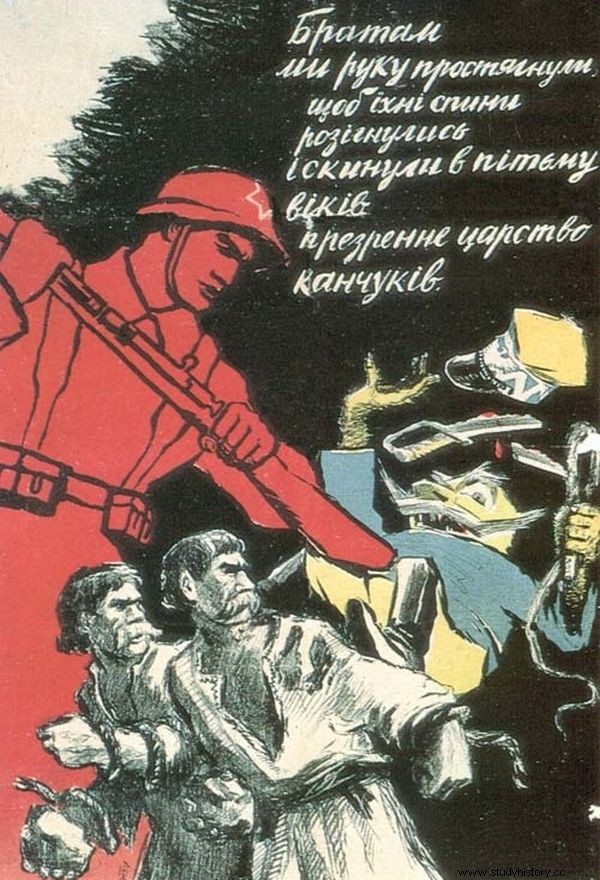
A Soviet soldier throws a Polish master off the peasant's back. Soviet propaganda, as always, in the highest form (source:public domain).
This was especially true of the so-called Lithuanians. They were Russified Jews who came from the east to the territory of the Kingdom of Poland at the turn of the 19th and 20th centuries under the influence of pogroms and anti-Jewish legislation in Russia.
How much truth in memories?
An honest historian cannot conclude his argument at this point, because the question of the credibility of the accounts, the examples of which are cited above, must be considered. Poles saw a diverse and complex group of Jews as an almost uniform mass. Source analysis shows that memoir writers have a clear tendency towards unauthorized generalizations and exaggerating phenomena.
This regularity can be seen especially when a given person writes about all Jews or the majority of them, and then gives only individual examples of cooperation with the new authorities. As Krzysztof Jasiewicz states:
Characteristic for Polish reporters (...) is the combination of all incidental and mass phenomena and creating a "cluster" of them - one mass phenomenon that suggests a high probability of massiveness.
Stories from the time of the Soviet occupation also often contain information about events that the author did not witness directly . Various kinds of rumors were very widespread.
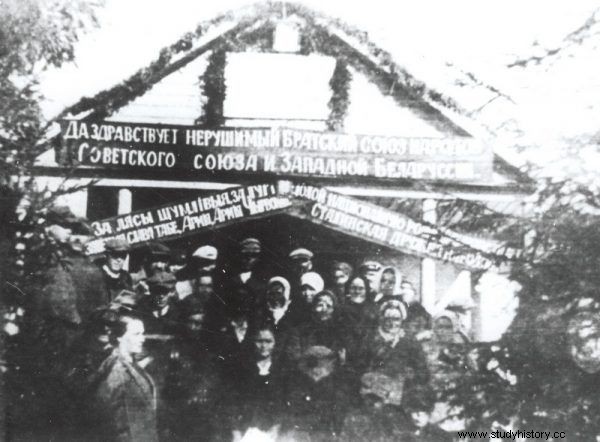
The population of the village of Grudziewicze in the district of Grodno solemnly welcomes the Red Army. The illustration comes from the book "The Trail of Hope" by Norman Davies, available at Znak.com.pl.
This is perfectly illustrated by the story from Grajewo, where:. On the edge of north-eastern Mazovia it was difficult not only to find Ukrainians, but also Belarusians.
The silence of sources
Even when we decide to trust the sources, the conclusions turn out to be at least ambiguous. Contrary to what some scholars have suggested, most accounts do not mention Jews welcoming the Red Army at all .
The aforementioned Krzysztof Jasiewicz carried out a detailed analysis of the memories from Kresy. Out of 237 reports about Białystok, any negative references to Jews (not only about their welcoming the occupant) appear in 88. In only 18, Jews are the only perpetrators of evil. In 46 cases it is about Belarusians, in 29 about Poles, in 73 about communists of unspecified nationality, and in 64 about criminals.
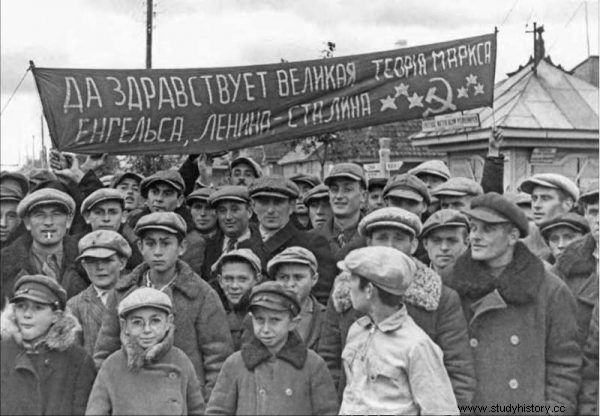
"Long live the great theory of Marx, Engels, Lenin - Stalin" (source:public domain).
Out of 123 reports from Lviv, 83 speak negatively about Jews, but only 3 authors saw them as the only collaborators. Most of these 83 do not mention Jews in the context of welcoming the Red Army. 71 people are listed as Ukrainians deserving of condemnation, 37 Poles, and 42 communists. With regard to Grodno, out of 79 reports, there are 34 indications of reprehensible behavior of Jews, while in Grajewo there are 5 out of 11.
In the case of the Łomża poviat, where Jedwabne, Radziłów and Wizna were located, where large pogroms took place in 1941, the scientist examined 219 reports. Jews appear as the perpetrators of evil in 86 of them (in 17 as the sole culprits), while Poles in as many as 91 (in 28 as the only ones). Only 17 reports (less than 8 percent!) Mention the welcoming of the Red Army by Jews.
This article has more than one page. Please select another one below to continue reading.Attention! You are not on the first page of the article. If you want to read from the beginning click here.
No Culpable Punishment
Massive - allegedly - greetings of the Red Army by the Jewish population and its subsequent comprehensive collaboration are often cited as an explanation for the 1941 pogroms against the Jewish population. The most famous of them is the one in Jedwabne.
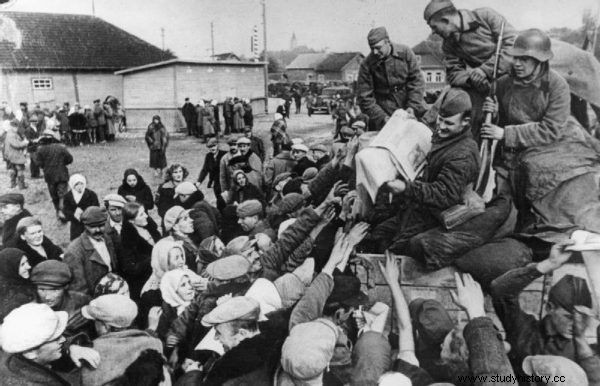
Soviet soldiers handing out propaganda press in the vicinity of Vilnius (source:public domain).
Of course, there can be no justification for the mass murder. Unfortunately, opinions about the justified reaction of the borderland population can be found not only in online discussions, but even in works at least seemingly scientific. Meanwhile, they are not only immoral, but also unfounded by facts .
The daughter of Bronisław Śleszyński, in whose barn the Jews of Jedwabne were burnt, recalled that the town was welcomed by only two Jewish and two Polish marriages. In 1941, Jews constituted 12.5 percent of the population of the Białystok region in which Jedwabne was located. What was their participation in the organs of Soviet power?

The article was inspired by the book by Władysław Bartoszewski, 'Poles - Jews - Occupation. Facts. Attitudes. Reflections "(Znak Horyzont 2016).
In January 1941, out of 403 political employees of the party apparatus in the oblast, only 56 were Jews (13.8 percent). In mid-1940, Jews made up 9.7 percent of 2,764 members and 1,206 candidates for party members. At the end of 1940, there were 69 Jews (6.2 percent) out of 1,114 representatives of executive authorities in the same district.
Until October 19, 1940, 118 Jews from the USSR were sent to the Łomża region (to which Jedwabne belonged), who constituted 8.2 percent of the so-called vostoczniks that is, people sent to take up administrative positions. In the entire Białystok region it was 16 percent.
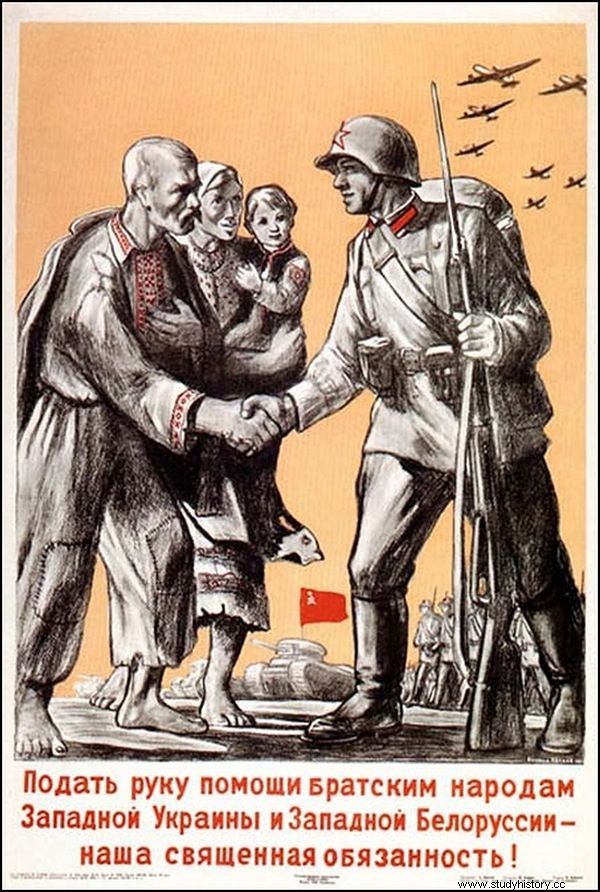
"To lend a helping hand to the fellow nations of Western Ukraine and Western Belarus - our sacred duty!" proclaims a propaganda poster from 1939 (source:public domain).
Among the so-called wywiżeńców , i.e. members of the local population promoted during the Soviet occupation, Jews in the Białystok region constituted 17.2 percent, of which 1/3 were teachers, and the majority were warehouse workers, shop assistants, etc.
These numbers, of course, although they varied from region to region, are not unique. Nowhere, from the Vilnius Region to Eastern Galicia, did the Jews constitute the dominant force in the broadly understood government apparatus.
